
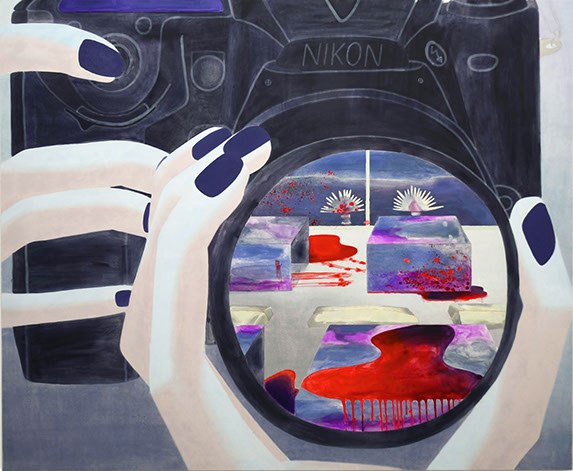
It's All Over Now, 2016
60" x 48", oil on canvas
photo: courtesy Tess Bilhartz
Sheryl Oppenheim with Tess Bilhartz
SO: Thank you for joining me Tess.
TB: Thank you for coming!
SO: When did this series for Purple Nights begin?
TB: I started working on this around last April. It actually started with a story that had been in my head for a long time. I jotted down parts of it in a journal over the course of a couple of years and last April I started thinking about approaching it more seriously. I wrote an outline, pretty detailed, of this narrative that I had in mind.
SO: Like a storyboard?
TB: Yeah, I think you saw the collaborative project that Holly Veselka and I had been working on, Snatch Vader’s Babies. It’s an apocalyptic Sci-Fi feminist B-horror movie about a viral infection. In Snatch Vader, an alien sends a virus to earth that affects only the women, inciting them all to homicidal blood lust. And they start killing all of the men. Ground zero for the infection is a karaoke bar in NYC.
SO: And there was something about vagina dentata that I think was involved in the conception of this.
TB: I think there was a lot of stuff involved in the conception.
SO: No pun intended.
TB: That might not have ultimately have made the project that we started working on.
SO: Was that the first time that you had worked on your paintings in a way that is sort of like a narrative? Was that the first time you were making work that actually resembled a comic strip or storyboard?
TB: It definitely was. Narrative is something that I’ve always been interested in. I read a lot of fiction and movies and dramas, but I never really found a way to make it a part of my work. One of the things that I really fell in love with about that project was that it suddenly freed me up to bring in everything that I had ever been interested in and it throw it at one project. And I think this work [Purple Nights] really comes out of that. That collaborative project helped me to see a way forward as a painter.
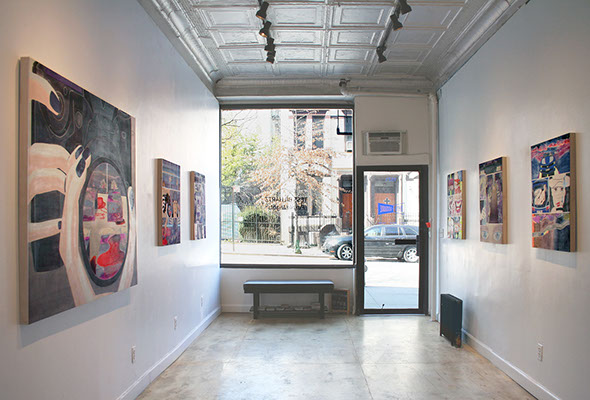
Purple Nights at Arts + Leisure
installation view
photo: courtesy Tess Bilhartz
SO: One thing I really like about the way these narratives are painted -with these lines dividing the canvas- is that it feels like it is answering the question of how you put everything into one painting. Dividing the painting up in smaller paintings on the same canvas is an interesting way of solving that.
TB: I always consider pulling them all apart. And occasionally that happens. Like in that one, the camera, I pull it out and it becomes its own painting. But one thing for me is the way all of these images work together in a single painting and it reads completely differently than if I made five paintings spaced out on a wall. Formally, it reads differently and also I think in terms of the narrative that it tells. One thing that has been intriguing me with this project is that I have a pretty specific narrative in mind, but when you see each of these paintings, separately, all of these things that I am thinking about aren’t apparent. There is an ambiguity to the narrative. It doesn’t tell you everything, and that question mark is one thing that these paintings convey.
SO: The palette in all of these paintings is really exceptional. It’s so specific and the colors together feel so strange. It’s unexpected. It feels like very much your own thing.
TB: I want them to feel strange. I spend a lot of time preparing the palette, just doing color tests, and I don’t want it to be jarring necessarily but I also don’t want it to be colors that sit totally at ease with each other.
SO: There is something kind of sickly about them –even in the way they encompass a dark night in the west, out in the open. They hint at something out of place.
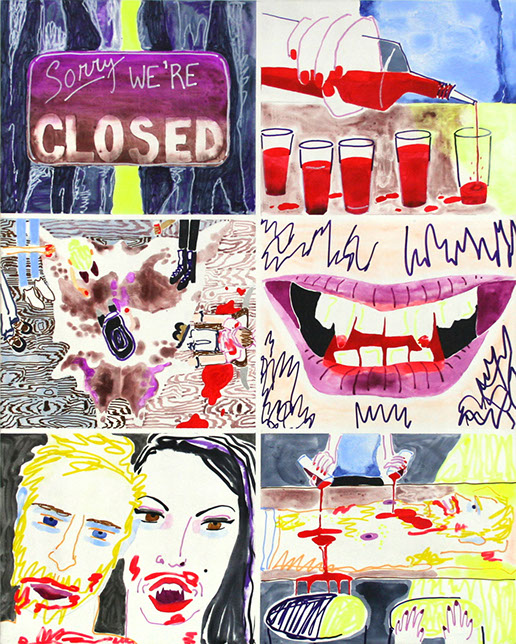
Sorry-Closed, 2015
20" x 24", oil on canvas
photo: courtesy Tess Bilhartz
TB: Like an ominous quality in a way. I want all indications to be something is not totally right.
SO: It's similar to a dream. You don’t know you’re in a dream, but you know that there shouldn’t be this green light. You haven’t gotten to the point where you realize you are dreaming, but you have the feeling "why is everything off..."
TB: Right, like you’re just one step out of line.
SO: I also really love Sorry-Closed –especially the last panel where the guy is on the counter doing body shots. It’s a strange double image in a lot of ways. For one thing, I feel like maybe that one in particular is the least constructed image in Purple Nights. The drawing is very economical, but it is also very abstract. If the guy’s face wasn’t there, or if the hands weren’t there...
TB: Right, what would you be looking at...?
SO: Right, and the way the nipples are drawn on is really funny. I feel like these paintings are so strange because all of the different panels have a different sense of perspective. Do you think about the spaces when you’re paintings these? How do you think about the spaces you’re creating?
TB: I think it’s something I’ve actually started to consider more and more as time goes on with this body of work. This painting was one of the early ones. I had this idea that after the bar closes these two women show up and it turns into a vampire bar. Kind of like dusk till dawn vampire bar and this is just supposed to convey that, like what happens after the bar closes, this is everything that’s going on here. But I also wanted it to be humorous. I didn’t want it to feel gory in a serious way, so I think part of the way that it is drawn is more abstract and gestural and rougher. It makes it come off as funnier and more absurd. In this one, I was thinking about the perspectives in a basic plot-driven way. In the more recent work I started to spend a lot more time considering the perspectives outside of the narrative engine, in a more intuitive way, and drawing and re-drawing them.
SO: I feel like text is a really strong element in a lot of the paintings even though it is very subtle. Like the word "Nikon" in It's All Over Now, and the word "Dark Energy" in the thought bubble... like you said, it was really scrawled on there and you tried to integrate it much more with the painting.
TB: The text for me, is kind of like another character. Each element in the painting -like the shots of blood, or the cowhide rug, or the text- functions in the same way as a character. The text, I’m not so much interested in by itself but I am interested in it as a single moment in this painting –and the way that it sometimes provides an entryway into the painting, like an introduction or a counter to what you are looking at.
SO: When you’re working on the narrative of these paintings, can you talk about the decisions that went into showing for example the plants? One thing I am curious about is how these are divided initially. It seems like a big choice from the beginning. Can you talk about how that decision gets made and incorporated into the painting as it grows?
TB: Each of the paintings has something I want it to say about this story. The one we’re looking at is a bar scene and the two women traveling have stopped off in a bar where they are strangers. When I am laying the paintings out, I do a lot of preliminary sketches and ultimately there are some really specific objects that say everything I want the story to say in a more abstract way. With this one [Sorry-Closed], I had the idea that I wanted to paint a cowhide rug. And that’s really how it started. I wanted the cowhide rug and I wanted the scull at the top of the bar. Everything else just starts to happen around it in a more organic way. So I had a basic idea of what I wanted there and I had a basic idea that I wanted the bar scene here, but I usually work panel to panel. So I did this one and then did that one so that each of them is a reaction to the one that came before. This [top panel in Deputy] is supposed to be a peyote
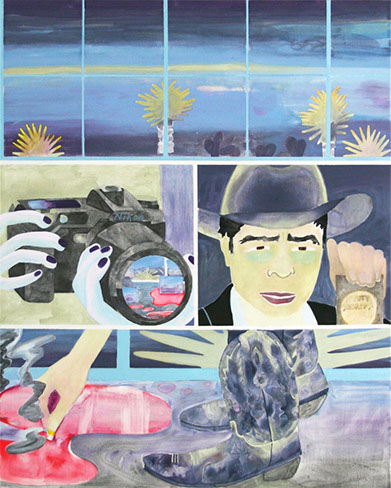
Deputy, 2015
24" x 30", oil on canvas
photo: courtesy Tess Bilhartz
cactus. It’s a motif in the story. It’s always there. But I feel the same way about the aloe cactus plants as I do about the cowhide rug. It’s hard for me to specifically express what I want them to say but I feel like as narrative elements they exist as importantly as anything that’s happening in the story. In some sense there is a hierarchy in the way that I start, and I want the whole painting to be about this one moment.
SO: On the opposite wall there are two paintings. It's All Over Now is the biggest painting in the exhibition. It’s one of the two paintings that isn’t made up of different cartoon panels. It’s just one image –although there is an image within an image. But then in the other painting, Deputy, the same images comes in again –the same image in the image in the painting. Can you talk about the relationship between the two?
TB: I think a lot about narrative timing. It's All Over Now stops the action. It’s a melodramatic tactic and it forces you to pause. The smaller, multi-panel painting, Deputy, came first. It drives the action forward, but the larger painting lingers on more abstract moments –like the landscape, the Judd sculptures, the fingers gripping the camera. It forces you to consider not only the active moment, but also the entire landscape that serves as its stage. Sometimes I think that each of these pieces are also just a way for me to figure out the next thing I want to paint.
SO: I’m interested because there is so much more information in Deputy. In particular, one of my favorite moments in the show is this bloody hand print reflected back in the camera.
TB: That’s what was kind of fun about it. I felt like there are a lot of moments that happen throughout all of these paintings that I painted one time in the context of a whole painting. But you’re right, there is a lot more information in It's All Over Now because I wanted to do it again and explore all of the possibilities of this painting; add a lot more information like this blood splatter.
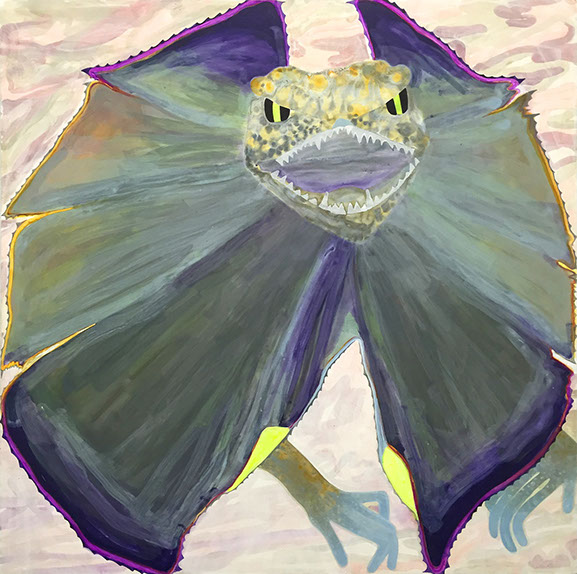
Lizard, 2016
36" x 36" oil and oil on canvas
photo: courtesy Tess Bilhartz
SO: It's All Over Now reminds me of a video game where you’re going and killing zombies with the post-apocalyptic landscape of cement blocks.
TB: Those are supposed to be Donald Judd sculptures. Repeating the imagery allows me to emphasize the things that I find interesting in the smaller versions. There was something about the hands that intrigued me so I could focus on them and explore them in a more thorough way –or this small landscape in the lens of the big camera or just all of these little devices that existed in the smaller version but I didn’t thoroughly explore. Ultimately these are all things I wanted to make paintings of. The more I paint from this story line, the more ideas I have to consider for paintings. This project slowly reveals to me the things that I am interested in painting.
SO: It almost seems like when you’re watching a trailer for a film. It's moving images, but it will be maybe 3 or 4 seconds of various scenes. All pieced together, they make for a really dynamic -oftentimes really dramatic- narrative.
Even though I am maybe not the right person to have a conversation with about this, there does seem to be a similar sense to film noir.
TB: Yeah, definitely. I love detective movies, and murder mysteries, and police procedurals and shit like that. I’m interested in the drama of it. They are actually really strange and beautiful and compelling to me. So I think a part of the decision making process in these paintings are pulling out those kinds of dramatic moments, and pulling out the ones that I really want to paint for some reason.
SO: It also seems with the way they are cropped, my eye as a viewer lands on different things. For example, the way the protagonist of these paintings might be on a late night drive in the middle of nowhere and just for a few seconds your eye lands on a cactus –or it lands on the feet of the woman walking down the runway. In life, that would just be three seconds of visual information may be carrying a real psychic weight. But it was an infinitesimal part of the experience of the evening. It is nice to have that caught and suspended in the narrative on the canvas.
TB: Absolutely. One of my informative experiences as an artist was the first time I took magic mushrooms in college and one of the things that was so intriguing to me about that experience was the way time would stand still and all of these seemingly random moments -like a school bus driving by, or an ant crawling across the ground- became infused with a really profound meaning and beauty. After those experiences, I began painting landscapes.
They were all trying to get back to that place where these little bitty moments suddenly felt like they had weight to them. And I think about that all of the time, even in this work. I think it informs the decisions I make with what to zoom in on and what movements to linger on.
SO: I like these because they are evocative of my own experience with these quotidian things you notice in

Purple Magic, 2016
24" x 30", oil on canvas
photo: courtesy Tess Bilhartz
the midst of other very normal human moments. I’ll use this example: you’re having a fight with a boyfriend and your eye falls on a piece of laundry on the floor. In that three seconds, the piece of laundry feels very tied to everything happening in the moment. You forget about it in the next moment, but I feel like we're noticing these zooms on different things in lived life too.
I am curious about your movie watching habits.
TB: I got a late start on all of that stuff. My family didn’t watch TV. By the time I got to college, I hadn’t seen or heard of anything. Like all of the people I knew were speaking a different language. So I think what happened was, as I slowly started to explore these worlds, I got obsessed. And I think it is definitely inspired a lot by movie watching and television, but also fiction. I’ve always been really interested in story telling in literature before I started watching movies and TV shows. When I was a child, I thought I would be a writer. But I think in some ways it is also a celebration of some of my baser interests. I genuinely like melodramas, and big epic stories, and archetypal villains, and heroes.
SO: As far as the road trips, did you actually go to West Texas and take these road trips yourself?
TB: On a couple of different occasions. Most recently I went with a couple of friends -Maggie and Nick- a couple of years ago. We took a road trip to Marfa, Texas. Some of the moments in this story are definitely connected to real life moments that we had there. But also, I grew up in Dallas and my family and I used to drive to Colorado every summer and winter. We had family there and we’d make the trek all the way across Texas into New Mexico and up through Colorado. So it wasn’t particularly southwest Texas –which is where this is set.

Do What Say Do, 2015
59" x 44", oil stick on canvas
photo: courtesy Tess Bilhartz
But I loved taking those trips and I loved the driving moments and I could entertain myself for hours just looking out of the window. I found that landscape really compelling as a child. It is so monotonous; it is completely empty out there –vast and empty. But there is something really beautiful about it to me, and I think it is something that has been in my head for years. Something that I have thought about is when you get up into New Mexico and southern Colorado there is that arid desert, you’re not in the mountains yet, you’re in this kind of flat desert with plateaus and a few vistas. So I have spent a lot of time driving through landscapes like that.
SO: There is something very romantic about this work and the implications of someone, or a group of people, in the middle of nowhere with few people around. When you’re like that, looking out into the open and looking out into the sky, it seems like the most fitting place to think about the world –how small we are and what is beyond the sky.
TB: Those kinds of experiences for me were really powerful. I have this nostalgia for those road trips. There is something about driving for long periods of time. The conversation goes in places where it hasn’t been before. There is an increased sense of intimacy. I think the reason why I wanted to set this body of work in that place was there is this kind of overwhelming emptiness to it. It’s like a stage and you can fill it with anything. Your thoughts take over and maybe that’s an inherent part of the road trip motif. You are driving and you are attached to all of the things that ground you less and less as you enter emptiness. The hierarchies of your reality shift.
SO: I’ve also heard it said that traveling and dancing are the two times when our normal sense of time is distorted. Traveling and dancing are both different ways of experiencing time than what we're used to. I look at these paintings and I think -even though I’ve never been to this part of the country, even though I would love to take a road trip there- it reminds me of being a teenager in Florida and driving at night an hour to the beach. There is something about the empty road and the sense of power a teenager can have –like a sense of mastery over the universe; almost like navigating through what feels more like space than a normal country road in the daylight.
TB: I think that is such an interesting point about time when traveling. When you have traveling companions, something strange happens too. You get so close to them in a very brief amount of time and you create this whole alternate universe and all of the problems you had before don’t really exist: you create a whole new set.
SO: That is interesting because it is for the duration of the travel you have assumed -or can pretend to have assumed- a different life, with a different set of needs and a different set of responsibilities. It’s the ideal way to assume an alternative identity while still maintaining a connection with the normal life that you’ll return to.
Do you feel like having made the work for this show that these stories are continuing? Do you feel like -now that all of this work is out there- there’s a break where there’s a change in palette and a change in the characters?
TB: I’ve been thinking about that a lot actually. I’m new to this project-based process. This body of work has a kind of beginning and an end which leaves me in sort of a strange place. I think at some point these characters and this story will be done and I will move on to something completely different, but I don’t know if it is that time yet.
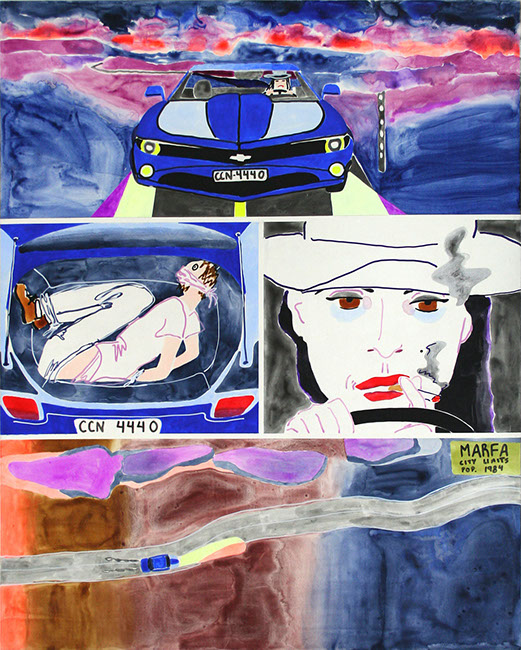
Chevrolet, 2015
24" x 30"
photo: courtesy Tess Bilhartz
SO: I keep coming back to these two paintings; the one with the man tied up in the trunk and the women smoking the cigarette –Chevrolet and the one next to it –Dark Energy. Can you talk about them?
TB: Chevrolet was actually the first painting I made in the series. It was kind of the opener to this whole western police procedural melodrama. I had an interesting studio visit with someone where we were talking about this painting as a preview for a movie. It’s not just a lineal narrative but each separate panel shows you a different aspect of what is going on and this painting with the guy tied up changes everything. You see this and this and this and then realize that something else is going on.
SO: Right, I feel like there’s a whole story here. They feel less like summaries than very concise ways of telling a story –especially the panel with the guy. I think the way you use drawing in all these paintings is interesting, especially when there’s so little specific information. The perspective on the trunk of the car for example, is very strange. Even what you use to make the guy –there’s the googly eyes that say, “oh shit I’m tied up in the back of a car!”
TB: I’m interested in short hand. In terms of the googly eye, just a few lines describe exactly what’s happening to this man. In the context of the painting, other elements of it aren’t painted that way at all.
SO: The one next to it, Dark Energy, is such a strange, beautiful painting. There’s so little that describes so much. It’s a lot like the way the eyes are painted. The thought bubble is such a strange moment. Can you talk about this painting?
TB: I love painting faces. I’m usually looking at someone pretty specific, even if it’s just a famous person that I’ve googled, it helps me. I like to have something to look at most of the time –even if it’s something on my ipad. Even when I’m not putting a lot of information in, I want it to convey a sense of what I’m looking at. That helps me with the faces and economy of marks. The thought bubble was a counter to the rest of the painting. It stops you. The rest of it -all these knick-knacks, the cactus, the candles, the wall paper, the tapestry- they’re all compelling. They’re things that we see all the time in houses and apartments. They’re all meaningful knick-knacks that are meaningless in a way. Everybody has them. I wanted the text to read kind of like a joke to stop you and reflect back the absurdity of it. She’s supposed to be a fortune teller. Originally, the text written was scrawled out. It was too jarring –too harsh. So I went back and incorporated it more into the painting.
SO: Do you ever get your fortune told?
TB: I have before. In graduate school one of the other grad students read our stars -everybody’s charts- and I had mine read. But it was actually pretty traumatic. It was a weird experience. It messed with my head. There was part of me that wanted to believe everything that he said.
SO: Even if it is bullshit, you can’t take back knowing this thing, whether or not it’s false.
TB: I’m about to have my chart read again for the first time since then.
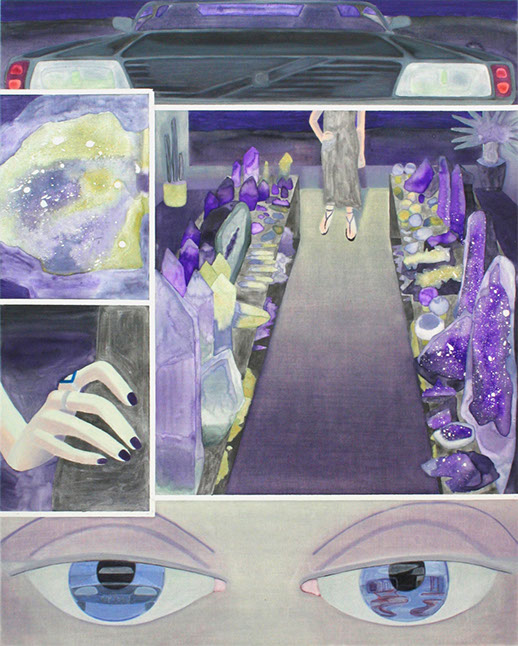
1985, 2015
24" x 30", oil on canvas
photo: courtesy Tess Bilhartz
Tess Bilhartz: Purple Nights
March 3 – April 3, 2016
Arts+Leisure
1571 Lexington Avenue
New York, NY 10029
Hours
Wednesday - Sunday
11am - 6pm or by appointment
Tess Bilhartz is an artist in Brooklyn, NY. Her solo exhibition Purple Nights runs through April 3rd at Arts + Leisure Gallery. Recent group exhibitions include Equinox, at The Willows, curated by Emily Wiener and Sharona Eliassaf, Brooklyn, NY; Four Sided Triangle, curated by Emily Kiacz, Spring Break Art Show, New York, NY; Art/ Work, BMCC Faculty Exhibition, Shirley Fiterman Art Center, New York, NY.
Sheryl Oppenheim is an artist and curator in Brooklyn, NY. Her work has been included in many recent exhibitions including Read Image, See Text, Cranbrook Museum of Art, Bloomfield Hills, MI; Expo Chicago with Regina Rex, Chicago, IL; Space Answers, Bannerette, Brooklyn, NY. Curatorial projects include Endless Care at Small Editions, Brooklyn, NY
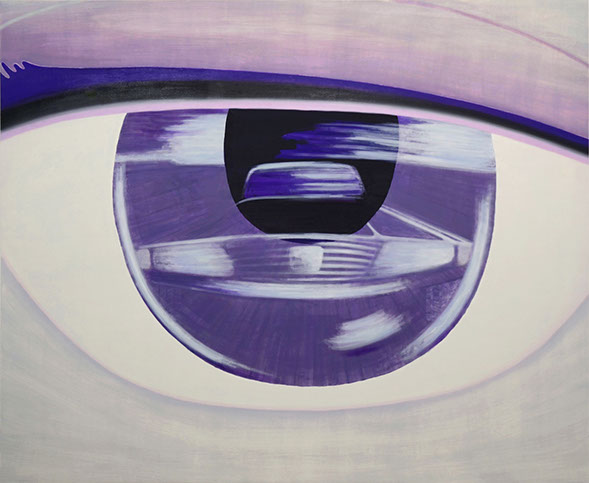
Eyeball, 2016
60" x 48"
photo: courtesy Tess Bilhartz
Disclaimer: All views and opinions expressed are those of the authors and do not necessarily reflect the views of the editors, owner, advertisers, other writers or anyone else associated with PAINTING IS DEAD.
